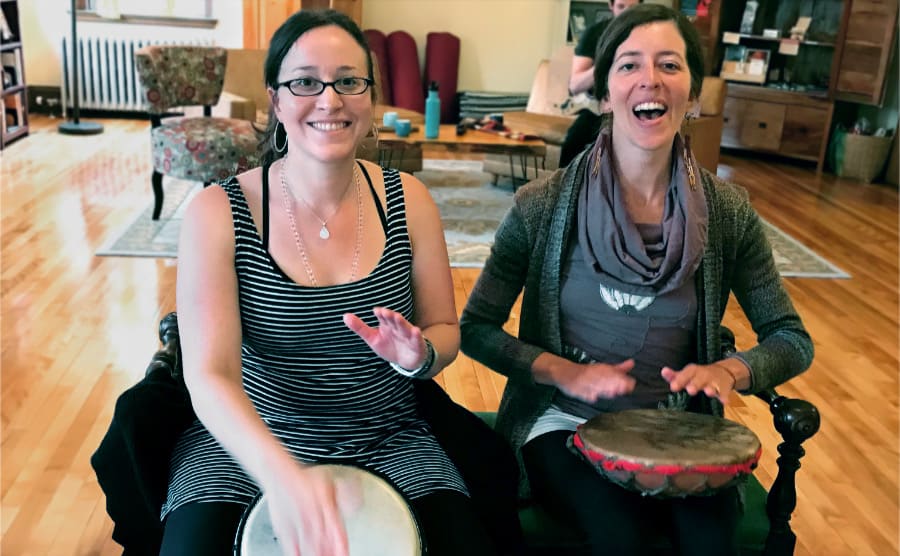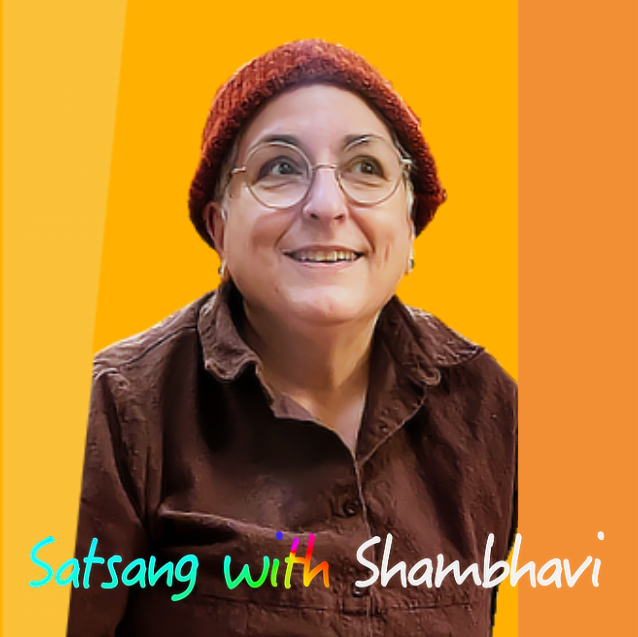Shambhavi talks about linear vs associative thinking, sensing time and good timing, and living without being distracted from the natural state. A podcast from Satsang with Shambhavi
Live satsang is mostly free range Q&A. “Tastings” are special episodes of our Satsang with Shambhavi podcast where you’ll get to listen as students ask all kinds of questions and Shambhavi responds. Welcome to the buffet version of satsang!
SHAMBHAVI
There's a phrase in Sanskrit—purna brahma narayani. It means full of awareness and creative energy.
If there is no emptiness anywhere, if everything is purna brahma narayani, everything is full of—as Abhinavagupta says—the glory of God consciousness.
From an absolute perspective, there's no direction. There's no line. There's no circle. There's no square. There's no triangle.
But of course, all those things are very fun—lines and triangles and squares and circles. We enjoy playing with those things!
And so that's what we call dualistic experience.
On one level, linearity and nonlinearity makes sense. I can have an experience that I am thinking something through according to the rules of Greco-Roman logic.
Or some other logic. For instance, the logic of ants. I could decide to study the logic of ants, and then talk about linearity in that context. Or the logic of a flower growing, and I could talk about linearity in that context.
Or I could talk about the linearity of solving a polynomial equation. Or I could try to figure out how to get the closest parking space in the most efficient amount of time at the supermarket.
There's all kinds of linearities that we can play with.
And then we can also play with non-linearies. For instance, associative thinking, or leaving your house not knowing where you're going and just having an adventure. Or a meandering conversation that is improvisational and really doesn't have any point other than enjoying that conversation.
So we experience linearity and nonlinearity in our experience in relative existence. And we enjoy those things.
Sometimes when people are being too linear, we say they're being too rigid. Or when they're being too non linear, we say you should do something to calm your Vata down. Your thinking is all scrambled.
But then, of course, linearity and nonlinearity have their enlightened aspects also. For instance, clarity—cutting to the chase, or cutting through the bullshit, or something. Those are aspects of linearity.
And aspects of non linearity—inspiration, and as I said earlier, associative thinking.
But none of these things are qualities of the absolute.
They're simply creative productions or modes of experiencing produced by the absolute. Like many other modes of experiencing that we have, those are just modes of experiencing.
One of the aspects of freedom is that we don't categorically reject any particular mode of experiencing. Modes of experiencing have their appropriate times.
So, for instance, if I'm looking for housing as I am right now, space for Jaya Kula and for me, if the landlord gave me a linear lease to look at, I would not say—You know, it'd be really nice if we just had a little picture of a flower here. And I'd really like to kind of like, riff with you on this section—that wouldn't be appropriate. [laughs]
I wouldn't get that lease!
So although we don't ultimately reject any mode of experiencing as being better or worse in any absolute sense, as we are living in so called linear time, then timing becomes one of the greatest skills that we can develop. How to feel for the right time for something.
We can actually develop a sensitivity that isn't intellectual. We can develop an embodied sensitivity to the right timing for something.
For instance, all of you probably have the experience that there's something important you want to say to a loved one. But you know it might be upsetting or it's something difficult to say. And so you're waiting for the right time.
Now, for some of us, that's just a procrastination mode. [laughs] The right time never comes!
But what I'm talking about is something different where we're literally feeling the texture of the fabric of time. When is the opening there? When is the right time?
So developing good timing is probably one of the very very top secrets to having a good life. And then knowing what's appropriate for the times.
A lot of the trouble that we get into is because we don't know what's appropriate for the times. We get a sort of an idea. We get very fixated on that idea or desire, and then we just pay no attention to the time or the appropriateness.
STUDENT1
Other than divination, what are some of your timing tools?
SHAMBHAVI
Well, just feeling. Like taking the time to feel for the time. And having the patience to wait if it doesn't feel like the right time. [laughs]
Yeah, good timing takes a lot of patience because we humans are going a lot faster than everything else.
So I often compare us to these annoying little speed boats. And the bigger picture of reality is a giant, giant ship that turns very slowly. It has many more components, and many more lives are happening.
And our little speedboat is like, come on! Come on! Come on! Come on! [laughs]
STUDENT1
Zipping around it.
SHAMBHAVI
Zipping around, yeah. Getting nowhere fast. [laughs]
So, patience. Astrology. But divination is really what schooled me in having a better embodied sense of timing.
Even just feeling for the right time to throw the coins is an aspect of that schooling, that training. I used to let people throw the coins themselves when they came for divination. I don't do that anymore.
But this is how my teacher did it. He would have you throw the coins. But sometime last year, I realized—hey, just because that's what he did, doesn't mean that's what I have to do. Because people would just be so, I want the answer! [mimics throwing coins quickly]
And I kept telling people—slow down! Slow down, feel for the time. And some people can do that. And some people can't. [laughs]
And of course, there's ordinary observation. Taking the time and stepping out of your compulsion long enough to observe what condition other people are in, or the circumstance.
You'll hear people say—Well, I knew this wasn't the right time for that, but I did it anyway. Or I knew I should have waited to say something to that person. But I didn't wait because I was anxious.
In that case, it's more that you did pick up on the ordinary cues, and you just didn't listen to them.
You didn't pause long enough to listen to them. And you didn't respect the circumstance of the other person enough to actually adjust your forward motion.
And of course, people who are people pleasers, who are afraid of anyone being angry with them, who never want to be criticized—those people are usually least patient. Because if they suspect anything is wrong or needs to be countered in some way, they will rush ahead and try to do that out of their own anxiety, not giving people enough time to process.
And part of that is like being aware of the different speeds at which people do, kind of figure out how they feel about things.
I learned this after many, many times, people getting aggravated with me. A lot of times it would happen after seeing a movie or something because I would have this instant response. And other people were like—I'm just thinking about it. The movie has only been over for 20 seconds. [laughs] Could you give me a moment?—But I've learned not to be that way.
But it could be much more serious than that where there's some heavy situation going on with you and other people, and you're not really giving them the space and time they need to figure out how they feel about things.
When I was much younger, I just was like, wait, you don't know how you feel about something? How could that be? [laughs]
But now I realize that's actually quite common. People do kind of find their way to what they're feeling about something at very different speeds.
STUDENT2
I'm curious about your experience with thinking when you meditate.
SHAMBHAVI
Thinking when I meditate.
STUDENT2
What happens with your thoughts? Do you have thoughts that go in lots of different places? Or have you found after all the years of practice that you have something fundamentally different going on than just random thoughts happening.
SHAMBHAVI
There's a couple of things you can look for, or feel for. One looking for and one feeling for.
So the looking for thing is a standard Buddhist thing. You can look and see how your thoughts arise and subside.
They're very, very, very ephemeral. You can just watch them arising and subsiding, rather than letting yourself get swept away by them.
But that's not our practice. Our practice is identifying through our perceptions a more embodied identification of the base state from which the thoughts are arising. And then just resting in that.
The basic orientation in this kind of tradition—not just Trika Shaivism, but many direct realization traditions—is to unmind the mind.
So rather than paying more attention to what thoughts are doing, or thinking about thoughts, or noticing the content or the quality of thoughts, or looking at thoughts and saying thought. And then, of course, it stops, right? Temporarily.
But in this kind of tradition we say unmind the mind. Which is let them do whatever they want. And we are resting in the base state. We are resting in the natural state. We are resting in living presence. And if thoughts happen, it's not a big deal.
The reason for this is that our practice is to live in the world. Ultimately—not that any of us are going to have this experience—but ultimately to be Jivanmukti, liberated in life.
And the thing is that life has thoughts. Life has traffic. Life has ups and downs. Life has non-ideal environments. Life has sickness. Life has busyness and all kinds of things happening.
So if we're going to be Jivanmukti, we have to learn to live in life and not be distracted from the natural state.
So that's what we are training to do. We are training to identify living presence, or the natural state, or that from which phenomena are arising, whether it's our thoughts or something else. And to be able to integrate our sense of self, our awareness, our perceptions with the natural state from which everything is arising.
And then furthermore, to experience everything that's arising as an aspect of the natural state. So that there's no difference really in our experience between a thought, and a non-thought, and no thought.
You'll hear in a lot of more normative Hindu traditions that enlightenment is having no thoughts, which I always thought was just such a ridiculous idea.
There's a wonderful, wonderful book, that I've told the story so many times. It's called The Tripura Rahasya. It's a South Indian purana, a series of stories that are meant to teach us about life and reality.
And there are two central characters in this story, a husband and a wife. Like many of these stories, the wife is a hidden yogini. So as this first starts out, the man thinks he's the great yogi. His wife is just an afterthought. [laughs]
But it turns out she is just way more realization than he does. And slowly over the course of the story, he discovers that and she becomes his teacher.
But anyway, somewhere in the middle of it, he's meditating, and she goes to him and she says, Husband, what would you like for lunch?
And he opens his eyes, and he looks up at her and he says, Now, go away, woman! I want to close my eyes again and get back to my blissful state.
And she says, Husband, if your blissful state depends on whether a half an inch of skin is open or closed, it really isn't all that. [laughs]
So it turns out that realization is realization in all circumstances, not just when our thoughts are calm or we're not having thoughts or anything like that.
So in this tradition thoughts really aren't all that important. We don't really do a lot with our thoughts like they do in a lot of Buddhist traditions.
Some people have very busy minds, and in that case, the idea is that you would practice Ayurveda or some other modality and calm your inner winds. That you would maybe do some mind training.
So there are things that we can do if our thoughts are really disturbing them. And we have a habit of following them. But in general, after that happens, we are not really paying that much attention to them.
STUDENT2
I've noticed that the thoughts I have don't bother me. I can sort of see them rise and fall. That's fine. But I noticed that there are times where I get swept away by them.
SHAMBHAVI
Yeah.
STUDENT2
And then there are times when I come back.
SHAMBHAVI
Yeah. So Ma said her famous vakya, she said—coming and going, the thing will be done.
She said this in many different ways. I first learned that teaching when I went to Varanasi for the first time. And a young man who had grown up with Ma translated a cassette tape he had of Ma giving teachings in Bengali, but he translated them for me in English.
And they are some of my most cherished Ma teachings, what he translated for me. And one of the things he translated was—coming and going, the thing will be done.
So the thoughts, you go out with the thoughts and then you come back. That process of being distracted and then coming back IS the process.
Everybody gets distracted, including me.
So the idea is that as you practice more, you become less distracted. And the times of distraction are fewer and farther between. They're not as long. And it's not as hard to pull yourself back.
But coming and going is the way. That's the road.
So that's good that you sometimes get distracted, but then you can come back.
And the more we come back, that's a very powerful gesture to come back from distraction.
Because distractions are not just neutral. They're things we enjoy. They are things that magnetize us and compel us.
So if we can draw that energy back and come back, that's a very powerful gesture. That is an absolutely key aspect of the re-patterning that happens as we do sadhana.
Our ability to come back is almost kind of scientific. Our compulsions are the things that compel us, that magnetize us. Our distractions, our habit patterns have literal momentum. They have force.
Our sadhana also has force. It also has desire impelling it. Both of them have the force of desire impelling them.
And as we practice, the desire to remain immersed in presence, to experience that continuity and connection with life eventually become stronger, literally, more forceful than the attractions.
And the attractions that used to be very compelling become less so. And they become less also in our conscious thoughts.
So if there's some kind of food that we were in the habit of eating that makes us sick, over time we are going to find that less delicious.
Maybe we still think it's delicious, but we actually don't want it. Because we're not willing to trade eating that food for feeling sick anymore. Whereas we used to make that trade.
And it's the same thing with relationships or jobs. And we all are uneven. For instance, I've just never been able to work at a job that I didn't like. I mean, literally unable. Other people stay in jobs they don't like for years. On the other hand, I've been trying to quit coffee for, like, 40 years. [laughs]
And talk about coming and going. My God! [laughs]
Sometimes I'll stop drinking for years, and then I'll just keep coming back. But sometimes it'll be like one day on and three days off. Then two days on and whatever. But, you know, it's a joke.
So we're not going to be even. We're all going to be unique in our relationship to these things.
Sign up to receive email updates
Enter your name and email address below and I'll send you periodic updates about the podcast.


